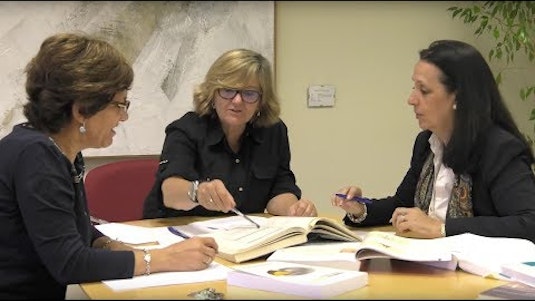
Moocable is learner-supported. When you buy through links on our site, we may earn an affiliate commission.
Description
This course is for those who want to fully master Algebra with complex numbers at an advanced level.
The prize at the end will be combining your newfound Algebra skills in trigonometry and using complex variables to gain a full understanding of Euler’s identity. Euler's identity combines e, i, pi, 1, and 0 in an elegant and entirely non-obvious way and it is recognized as one of the most beautiful equations in mathematics.
Tags
Syllabus
- Introduction: Why study Euler's Formula?
- Algebraic Intuition: Warm up your algebraic skills and intuition with this opening set!
- Why Complete This Course?: What are complex numbers good for?
- The Pathway to Euler's Formula: This is one of the most beautiful theorems in mathematics.
- Complex Numbers: From the basics to fractals.
- It's Not A Real Number: Get started with an introduction to complex numbers and complex arithmetic.
- Imaginary Powers: Explore the patterns that emerge when complex numbers are squared and cubed.
- Real and Imaginary Parts: Think about complex numbers as a combination of their real and imaginary components.
- The Complex Plane: Graph complex numbers and build intuition for representing them as vectors.
- The Triangle Inequality: Apply a geometric theorem to see an algebraic truth.
- Arithmetic Shortcuts: Learn some tricks and get creative in how you simplify these complex expressions!
- Multiplying Complex Numbers: Visualize complex products as rotations on the complex plane.
- Complex Exponents: Extend your intuition for complex products to the case of exponentials.
- The Mandelbrot Set: Use complex numbers to create and explore fractals!
- Julia Sets: Explore how fractal symmetry is the result of specific properties and symmetries of complex arithmetic.
- Functions and Transformations: Slide it, squeeze it, stretch it, flip it.
- Functions Warm-up: Review the key principles of mathematical functions!
- Domain & Range: What happens if a function's input or output is restricted?
- Transforming Functions: Practice applying and visualizing function transformations.
- Transforming Functions Practice: Further strengthen your skill with transformation techniques by solving these challenges.
- Symmetries and Isometries: Use transformations to rotate and reflect functions.
- Complex Transformations: Extend what you know about transformations to the complex plane.
- Composition: Create nests and chains of multiple functions.
- Inverses: Can these functions be run in reverse?
- Composition and Inversion: What happens when you combine chaining functions with flipping the input and output.
- Recursion and Limits: What happens if composition is repeated again, and again, and again...?
- Koch's Snowflake: Use recursion to draw a new type of fractal!
- Polynomials: It's the Fundamental Theorem of Algebra.
- A Golden Polynomial: Review the mathematics of polynomials and discover the golden ratio.
- Finding Roots: Learn and practice several polynomial root-finding techniques.
- How Many Roots?: Apply the Factor Theorem while studying roots and multiplicity.
- Graphs of Polynomials: What do polynomials look like?
- Graphs and Repeated Roots: Contend with polynomial graphs that include repeated roots.
- Complex Roots: If a root isn't visible in the real plane, that's because it's hiding in the imaginary part of space.
- Factoring with Real Coefficients: Study some general techniques for factoring polynomials.
- Exponential Equations: A doomsday forecast if left unchecked.
- Exponents Warmup: Review the foundational skills for working with exponents.
- Defining Exponents: Strengthen your intuition for how exponents behave.
- Laws of Exponents: Explore and practice applying the algebraic laws of exponents.
- The Growth Rate of Exponential Sequences: How quickly do exponential functions grow?
- Modeling Exponential Growth: Match each growth scenario with a mathematical description.
- Doomsday Scenarios: Explore what happens when populations are overtaken by infections that propagate exponentially.
- Finance and Exponents: Connect the worlds of money and math.
- Domain and Range Misconceptions: Lean how to avoid some common pitfalls.
- Logarithms: Is it all about the base?
- Defining Logarithms: Understand the role of each component of a logarithmic expression.
- Log Scales: Use exponential scaling to visualize data in a useful way.
- Understanding Log Arithmetic: Leverage your experience with logarithmic scales to understand the arithmetic rules for logarithms.
- Log Arithmetic Practice: Practice applying the arithmetic log rules you recently derived.
- The Change of Base Formula: Learn, visualize, and apply a formula for changing bases.
- Graphing Logs: What do logarithms look like?
- Log Equations: Solve equations that contain logarithms.
- Applying Log Scales: Use logarithms to study data.
- Trigonometry: What is a sin(gerine) / cos(gerine)?
- Sine and Cosine: Get acquainted with the two fundamental functions of trigonometry.
- Conceptual Foundations: Explore the connection between the sine and cosine functions and steady movement around a circle.
- The Unit Circle: Develop an essential toolkit for understanding and calculating sine and cosine values.
- Trigonometry Graphs: What do the graphs of sine and cosine look like?
- Relating the Functions: Derive several trigonometric identities.
- Other Trigonometry Function Graphs: Explore some unusual trigonometry graphs, including secant and cosecant.
- Trigonometry Graphs Problem Solving: Creatively apply your skills with trig graphs to solve some challenging puzzles.
- Identities: What other relationships can we find relating multiple trig functions?
- Inverse Trigonometry: Learn about and apply the inverse trigonometric functions: arcsine, arccosine, and others.
- Polar Coordinates: The coordinate plane as a spider sees it.
- Conversion From Cartesian: What are polar coordinates and how are they related to traditional coordinates?
- Simpler in Polar Form: Sometimes using polar coordinates is more efficient and elegant than using x and y.
- Polar Transformations: Modify and visually transform graphs in polar form.
- More Transformations: Now rotate, translate, and reflect polar graphs!
- Rose Curves: Stop and enjoy this deep exploration of graphs that have petals.
- Graphing Complex Numbers: Extend polar graphing into the complex plane.
- Vector Space Transformations: First functions, but now let's warp space.
- Introduction to Transformations: What's a transformation function?
- Introduction to Vectors: What is a vector?
- Translation and Scaling: Apply transformations that move, grow, and shrink vectors.
- Identity and Reflection: What matrix can reflect a vector across the x- or y-axis?
- Rotation: What matrices can be used to rotate vectors around the origin?
- Multiple Transformations: Practice applying multiple transformations in a sequence.
- Inversion: Take a look at a transformation that turns vectors 'inside out.'
- Euler's Formula: You have reached the summit.
- Are You Ready for Euler's Formula?: Review all of the skills that you'll need to use in concert to understand Euler's Formula.
- Algebraically Manipulating the Formula: Use a bit of lite algebra to manipulate the terms in Euler's Formula.
- How to Approach the Trigonometry: Study the sine and cosine terms that are on one side of Euler's Formula.
- How to Approach Complex Exponents: Study the complex exponent that's on the other side of Euler's Formula.
- Adders: A new way to think about and visualize addition.
- Multipliers: A new way to think about and visualize multiplication.
- What Is Exponentiation?: A new way to think about and visualize exponentiation.
- Complex Exponentiation: Apply exponentiation to the complex form in Euler's Formula, and make sense of it all at once!
- Trig Identities with Euler's Formula: Use Euler's Formula to discover trig identities.
- Roots of Unity with Euler's Formula: Study the symmetrical points of the roots of unity.
- Physics with Euler's Formula: Use Euler's Formula to wrangle with waves.

-
TypeOnline Courses
-
ProviderBrilliant
This course is for those who want to fully master Algebra with complex numbers at an advanced level.
The prize at the end will be combining your newfound Algebra skills in trigonometry and using complex variables to gain a full understanding of Euler’s identity. Euler's identity combines e, i, pi, 1, and 0 in an elegant and entirely non-obvious way and it is recognized as one of the most beautiful equations in mathematics.
The prize at the end will be combining your newfound Algebra skills in trigonometry and using complex variables to gain a full understanding of Euler’s identity. Euler's identity combines e, i, pi, 1, and 0 in an elegant and entirely non-obvious way and it is recognized as one of the most beautiful equations in mathematics.
- Introduction: Why study Euler's Formula?
- Algebraic Intuition: Warm up your algebraic skills and intuition with this opening set!
- Why Complete This Course?: What are complex numbers good for?
- The Pathway to Euler's Formula: This is one of the most beautiful theorems in mathematics.
- Complex Numbers: From the basics to fractals.
- It's Not A Real Number: Get started with an introduction to complex numbers and complex arithmetic.
- Imaginary Powers: Explore the patterns that emerge when complex numbers are squared and cubed.
- Real and Imaginary Parts: Think about complex numbers as a combination of their real and imaginary components.
- The Complex Plane: Graph complex numbers and build intuition for representing them as vectors.
- The Triangle Inequality: Apply a geometric theorem to see an algebraic truth.
- Arithmetic Shortcuts: Learn some tricks and get creative in how you simplify these complex expressions!
- Multiplying Complex Numbers: Visualize complex products as rotations on the complex plane.
- Complex Exponents: Extend your intuition for complex products to the case of exponentials.
- The Mandelbrot Set: Use complex numbers to create and explore fractals!
- Julia Sets: Explore how fractal symmetry is the result of specific properties and symmetries of complex arithmetic.
- Functions and Transformations: Slide it, squeeze it, stretch it, flip it.
- Functions Warm-up: Review the key principles of mathematical functions!
- Domain & Range: What happens if a function's input or output is restricted?
- Transforming Functions: Practice applying and visualizing function transformations.
- Transforming Functions Practice: Further strengthen your skill with transformation techniques by solving these challenges.
- Symmetries and Isometries: Use transformations to rotate and reflect functions.
- Complex Transformations: Extend what you know about transformations to the complex plane.
- Composition: Create nests and chains of multiple functions.
- Inverses: Can these functions be run in reverse?
- Composition and Inversion: What happens when you combine chaining functions with flipping the input and output.
- Recursion and Limits: What happens if composition is repeated again, and again, and again...?
- Koch's Snowflake: Use recursion to draw a new type of fractal!
- Polynomials: It's the Fundamental Theorem of Algebra.
- A Golden Polynomial: Review the mathematics of polynomials and discover the golden ratio.
- Finding Roots: Learn and practice several polynomial root-finding techniques.
- How Many Roots?: Apply the Factor Theorem while studying roots and multiplicity.
- Graphs of Polynomials: What do polynomials look like?
- Graphs and Repeated Roots: Contend with polynomial graphs that include repeated roots.
- Complex Roots: If a root isn't visible in the real plane, that's because it's hiding in the imaginary part of space.
- Factoring with Real Coefficients: Study some general techniques for factoring polynomials.
- Exponential Equations: A doomsday forecast if left unchecked.
- Exponents Warmup: Review the foundational skills for working with exponents.
- Defining Exponents: Strengthen your intuition for how exponents behave.
- Laws of Exponents: Explore and practice applying the algebraic laws of exponents.
- The Growth Rate of Exponential Sequences: How quickly do exponential functions grow?
- Modeling Exponential Growth: Match each growth scenario with a mathematical description.
- Doomsday Scenarios: Explore what happens when populations are overtaken by infections that propagate exponentially.
- Finance and Exponents: Connect the worlds of money and math.
- Domain and Range Misconceptions: Lean how to avoid some common pitfalls.
- Logarithms: Is it all about the base?
- Defining Logarithms: Understand the role of each component of a logarithmic expression.
- Log Scales: Use exponential scaling to visualize data in a useful way.
- Understanding Log Arithmetic: Leverage your experience with logarithmic scales to understand the arithmetic rules for logarithms.
- Log Arithmetic Practice: Practice applying the arithmetic log rules you recently derived.
- The Change of Base Formula: Learn, visualize, and apply a formula for changing bases.
- Graphing Logs: What do logarithms look like?
- Log Equations: Solve equations that contain logarithms.
- Applying Log Scales: Use logarithms to study data.
- Trigonometry: What is a sin(gerine) / cos(gerine)?
- Sine and Cosine: Get acquainted with the two fundamental functions of trigonometry.
- Conceptual Foundations: Explore the connection between the sine and cosine functions and steady movement around a circle.
- The Unit Circle: Develop an essential toolkit for understanding and calculating sine and cosine values.
- Trigonometry Graphs: What do the graphs of sine and cosine look like?
- Relating the Functions: Derive several trigonometric identities.
- Other Trigonometry Function Graphs: Explore some unusual trigonometry graphs, including secant and cosecant.
- Trigonometry Graphs Problem Solving: Creatively apply your skills with trig graphs to solve some challenging puzzles.
- Identities: What other relationships can we find relating multiple trig functions?
- Inverse Trigonometry: Learn about and apply the inverse trigonometric functions: arcsine, arccosine, and others.
- Polar Coordinates: The coordinate plane as a spider sees it.
- Conversion From Cartesian: What are polar coordinates and how are they related to traditional coordinates?
- Simpler in Polar Form: Sometimes using polar coordinates is more efficient and elegant than using x and y.
- Polar Transformations: Modify and visually transform graphs in polar form.
- More Transformations: Now rotate, translate, and reflect polar graphs!
- Rose Curves: Stop and enjoy this deep exploration of graphs that have petals.
- Graphing Complex Numbers: Extend polar graphing into the complex plane.
- Vector Space Transformations: First functions, but now let's warp space.
- Introduction to Transformations: What's a transformation function?
- Introduction to Vectors: What is a vector?
- Translation and Scaling: Apply transformations that move, grow, and shrink vectors.
- Identity and Reflection: What matrix can reflect a vector across the x- or y-axis?
- Rotation: What matrices can be used to rotate vectors around the origin?
- Multiple Transformations: Practice applying multiple transformations in a sequence.
- Inversion: Take a look at a transformation that turns vectors 'inside out.'
- Euler's Formula: You have reached the summit.
- Are You Ready for Euler's Formula?: Review all of the skills that you'll need to use in concert to understand Euler's Formula.
- Algebraically Manipulating the Formula: Use a bit of lite algebra to manipulate the terms in Euler's Formula.
- How to Approach the Trigonometry: Study the sine and cosine terms that are on one side of Euler's Formula.
- How to Approach Complex Exponents: Study the complex exponent that's on the other side of Euler's Formula.
- Adders: A new way to think about and visualize addition.
- Multipliers: A new way to think about and visualize multiplication.
- What Is Exponentiation?: A new way to think about and visualize exponentiation.
- Complex Exponentiation: Apply exponentiation to the complex form in Euler's Formula, and make sense of it all at once!
- Trig Identities with Euler's Formula: Use Euler's Formula to discover trig identities.
- Roots of Unity with Euler's Formula: Study the symmetrical points of the roots of unity.
- Physics with Euler's Formula: Use Euler's Formula to wrangle with waves.
Tags
Related Courses


Matemáticas y Estadística: entiéndelas, úsalas

Funciones algebraicas y trascendentes

Machine Learning Algorithms

Statistics 2 Part 2: Statistical Inference

Statistical Mechanics

Inferential Statistics

Statistics Foundations: The Basics

SAT Prep: Tutoring Solution

Programming Foundations: Discrete Mathematics

UExcel Precalculus Algebra: Study Guide & Test Prep

Math 105: Precalculus Algebra
Loading...
Saving...
Loading...

 Online Courses
Online Courses  Brilliant
Brilliant
